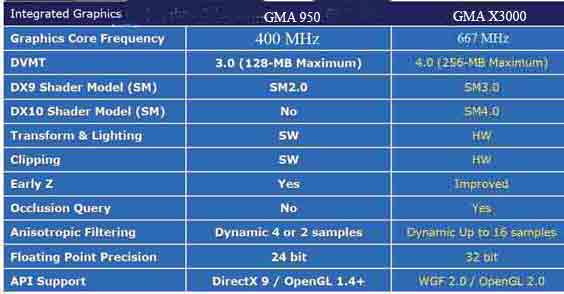Some of us may be surprised to read this news as previous Intel's GMAs chips was low performing and very slow in 3D games applications. But this may take a complete turn-off with the next gen IGP from Intel. The G965's graphic chip as been officially named GMA x3000. It will be the first to release a Direct X 10 IGP solution to entry level systems.

GMA 950 image on the left and GMA X3000 image on the right
Other new features and improvements will include: Shader Model 4.0, DVMT 4.0, hardware T&L and clipping, improved Early Z engine with new Occlusion Query, improved Anisotropic Filtering with Dynamic 16 sample, upgraded 32bit Floating Point Precision and the new Clear Video technology. We also note the executions units programmability. Differing from other chipsets that separate the 3D rendering unit and video processing unit, Intel 's GMA X3000 have merged them into a single programmable execution units. This flexible design of the units will ensure that every execution unit are working, thus enhancing the performance.
Intel's Clear Video will compete versus ATi's AVIVO and nVIDIA's Purevideo. Giving the standard hardware decoder for WMV9B (iDCT/VC1), MPEG-2, H.264, etc. It will give to the user, always on hardware side, the possibility to do real time encode a MPEG-II movie when playing HD stream video in same time all this by using little CPU loads. Support up to 1080p resolution and Picture in Picture, HD video and SD video can be displayed in the same time. Also, Advanced de-interlacing algorithms will give better image quality for interlaced content. Finally, the build-in ProcAmp color control settings allow user adjustment of hue, saturation, brightness, and contrast. Intel's GMA x3000 will also support HDMI, HPCP, and DUI interfaces making up a full compatible platform to the today and tomorow HD standards.
Differences between GMA 950 on 945G motherboards and GMA X3000 on G965 motherboards

Perhaps the largest improvement of GMA X3000 over GMA 950 is the move away from a fixed function pipeline in favor of a programmable pipeline. NVIDIA and ATI abandoned fixed function pipelines in 2001.
Intel’s latest motherboard update has more detailed information on the Graphics Media Accelerator X3000. DirectX 9 features such as Pixel Shader 3 and Vertex Shader 3.0 are supported. This time around the Vertex Shader 3.0 units are hardware based instead of the software based shaders found in previous GMA900/950 and Extreme graphics cores. A hardware transform and lighting engine has also been integrated and a significant improvement over the previous software T&L engine. High dynamic range is also supported for great realism in gaming. Lastly the GMA X3000 graphics core will be clocked up to 667 MHz -- quite a bit higher than current budget ATI and NVIDIA offerings.
Video output capabilities of the GMA X3000 are limited to a native VGA output. HDMI, DVI, UDI, component, composite and S-Video can be added through the SVDO port or with an ADD2 expansion card like the previous GMA900/950 graphics cores. This more or less indicates HDCP compliance will be left up to the motherboard manufacturer or ADD2 card manufacturer. GMA X3000 will support resolutions up to 2048x1536 including 720p/1080i/1080p in 16:9, 4:3 and letterbox aspect ratios.
Intel Clear Video Technology will provide algorithms and features to improve video playback. Clear Video Technology will have plenty of graphics power to simultaneously playback one high definition and one standard definition video stream for picture-in-picture. Hardware acceleration for high definition MPEG2 and VC1 is supported. However, it doesn’t look like Intel will offer hardware acceleration for H.264 at this time. An advanced de-interlacing algorithm is also integrated for improved video quality of interlaced sources such as DVD’s and cable programming. The built-in advanced pixel adaptive de-interlacing algorithm supports standard and high definition video content up to 1080i lines of resolution.
the consumer level G965 Express receives the GMA X3000 graphics core, Q965 Express chipsets receive the GMA 3000 graphics core. Differences between the GMA X3000 and GMA 3000 include the lack of Intel Clear Video Technology on the GMA 3000.
One thing that is important to remember about the GMA X3000 family is that it is a completely programmable pipeline architecture -- meaning Intel only needs to update the microcode to add support for features like SM 4.0. This opens the door to a few possibilities with where Intel can go with the architecture. For example, since the Santa Rosa notebook platform is based on G965, but will not launch until next year, Intel may take the opportunity to add better features to the core.
G965 Express is expected to launch the last week of July with Core 2 processors while Q965 Express is expected to launch the first week of September with Intel’s vPro business platform.
